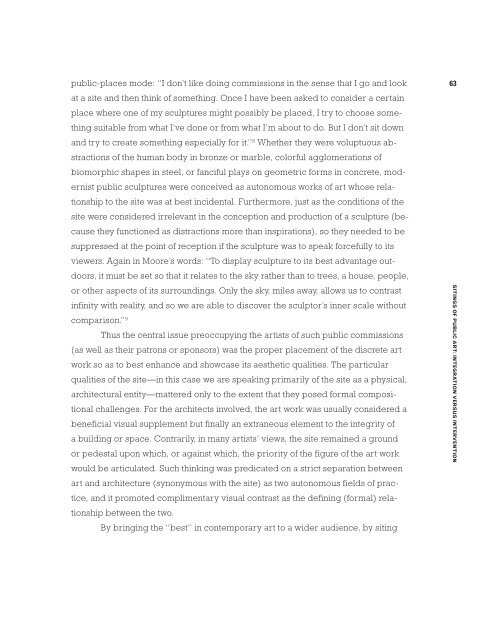ONE PLACE AFTER ANOTHER - Monoskop
ONE PLACE AFTER ANOTHER - Monoskop
ONE PLACE AFTER ANOTHER - Monoskop
You also want an ePaper? Increase the reach of your titles
YUMPU automatically turns print PDFs into web optimized ePapers that Google loves.
public-places mode: “I don’t like doing commissions in the sense that I go and look<br />
at a site and then think of something. Once I have been asked to consider a certain<br />
place where one of my sculptures might possibly be placed, I try to choose something<br />
suitable from what I’ve done or from what I’m about to do. But I don’t sit down<br />
and try to create something especially for it.” 8 Whether they were voluptuous abstractions<br />
of the human body in bronze or marble, colorful agglomerations of<br />
biomorphic shapes in steel, or fanciful plays on geometric forms in concrete, modernist<br />
public sculptures were conceived as autonomous works of art whose relationship<br />
to the site was at best incidental. Furthermore, just as the conditions of the<br />
site were considered irrelevant in the conception and production of a sculpture (because<br />
they functioned as distractions more than inspirations), so they needed to be<br />
suppressed at the point of reception if the sculpture was to speak forcefully to its<br />
viewers. Again in Moore’s words: “To display sculpture to its best advantage outdoors,<br />
it must be set so that it relates to the sky rather than to trees, a house, people,<br />
or other aspects of its surroundings. Only the sky, miles away, allows us to contrast<br />
infinity with reality, and so we are able to discover the sculptor’s inner scale without<br />
comparison.” 9<br />
Thus the central issue preoccupying the artists of such public commissions<br />
(as well as their patrons or sponsors) was the proper placement of the discrete art<br />
work so as to best enhance and showcase its aesthetic qualities. The particular<br />
qualities of the site—in this case we are speaking primarily of the site as a physical,<br />
architectural entity—mattered only to the extent that they posed formal compositional<br />
challenges. For the architects involved, the art work was usually considered a<br />
beneficial visual supplement but finally an extraneous element to the integrity of<br />
a building or space. Contrarily, in many artists’ views, the site remained a ground<br />
or pedestal upon which, or against which, the priority of the figure of the art work<br />
would be articulated. Such thinking was predicated on a strict separation between<br />
art and architecture (synonymous with the site) as two autonomous fields of practice,<br />
and it promoted complimentary visual contrast as the defining (formal) relationship<br />
between the two.<br />
By bringing the “best” in contemporary art to a wider audience, by siting<br />
63<br />
SITINGS OF PUBLIC ART: INTEGRATION VERSUS INTERVENTION

















